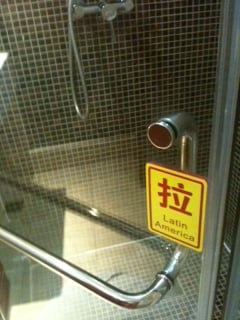The difference between “pull” and “Latin America”
 Source: languagelog.ldc.upenn.edu
Source: languagelog.ldc.upenn.edu
This appeared in one of my favorite language blogs recently, and was too good not to share. I live in China, and often see poorly translated English signage all over the place, but rarely is something this badly (and unintentionally hilariously) translated.
This sign was found on a shower door – the Chinese character (拉 – “lā”) simply means “pull”. However, its translation here is given as “Latin America”.
While the reason why this was chosen as the best translation by the makers of the sign is a little unclear, this is Victor from Language Log’s best guess:
So how did the injunction to “Latin America” come into the picture? Some oaf who was charged with making the sign managed to find lā 拉 in their dictionary and must have been overwhelmed by the plethora of English glosses: pull, drag, draw, haul, help out, implicate, play (a stringed instrument), chat, a verbal suffix, and so forth. Bewildered, they would have spotted near the end of the entry for lā 拉 that it is also an abbreviation for Lāměi 拉美, which is in turn a short form of Lādīng měizhōu 拉丁美洲, which means “Latin America”.
Why didn’t the oaf choose the first and simplest definition, “pull”? I suppose that they thought that the English (Roman letter) part of the sign is for foreigners, so it might be smart (!!) to use the only obviously foreign definition in the dictionary: Latin America. That’s the best defense I can give on behalf of the individual who made this sign. Actually, it’s not really a defense, merely one possible explanation for this mind-boggling choice. I suppose it’s also possible that they didn’t understand any of the English glosses, and simply felt that the longest one must be the most informative.
Brilliant!
